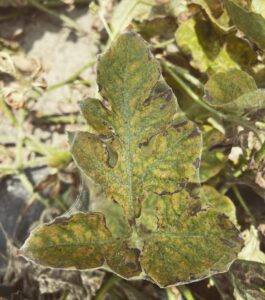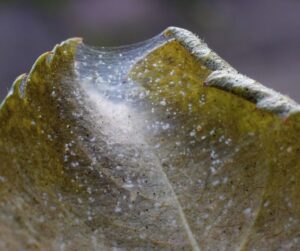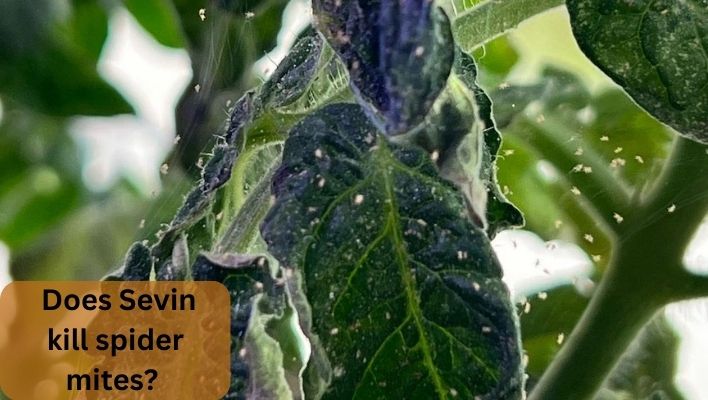Spider mites are a common garden pest that can wreak havoc on your plants. These tiny pests, often too small to be seen with the naked eye, belong to the arachnid family and feed on the sap of plants, causing damage and discoloration. If left unchecked, spider mites can quickly multiply and infest your entire garden.
These tiny arachnids might be small, but their ability to cause significant damage to plants is astonishing.
Fortunately, there are various pest control solutions available, and one popular option is Sevin insecticide. Sevin has gained a reputation as an effective tool in the fight against garden pests, including spider mites.
Its effectiveness and versatility have made it a popular choice among gardeners looking to protect their plants from these troublesome critters.
Below, we will delve into the effectiveness of Sevin and explore whether it truly lives up to its claims as a spider mite killer.
So, if you’ve been battling spider mite infestations and are considering using Sevin, keep reading to discover if this insecticide can help you regain control of your garden.
What are Spider Mites?
Spider mites are tiny arachnids that belong to the Tetranychidae family. Despite their name, they are not true spiders but rather closely related to spiders and ticks.
These microscopic pests measure less than 1 millimeter in size, making them barely visible to the naked eye.
Characterized by their eight legs and oval-shaped bodies, spider mites come in a variety of colors, including red, yellow, green, and brown.
They are commonly found in warm and dry environments, thriving in conditions where humidity is low. These conditions make them a persistent problem, especially during the hot summer months.
Spider mites are sap-sucking pests that feed on the fluids of plants, piercing the cell walls and extracting vital nutrients. Their feeding activity weakens the plants, leading to visible damage.

As they feed, spider mites leave behind a fine, silky webbing, which they use for protection and transportation. This webbing can engulf leaves and branches, suffocating the plant and hindering photosynthesis.
The damage caused by spider mites includes stippling or speckling on the leaves, which appear as small yellow or white dots. If you are wondering if you have soil mites or other pes
As the infestation worsens, the leaves may turn yellow, brown, or even become completely defoliated. Additionally, severe infestations can lead to stunted growth, reduced fruit production, and even plant death.
It’s essential to address spider mite infestations promptly to prevent significant damage and the spread to neighboring plants. Effective pest control measures, such as using Sevin insecticide, can help mitigate the damage and restore the health of affected plants.
Understanding Sevin
Sevin is a widely-used insecticide that has gained popularity among gardeners and homeowners for its effectiveness in controlling a wide range of pests. Its active ingredient, carbaryl, belongs to the carbamate class of chemicals.
Sevin works by targeting the nervous system of pests, including spider mites. When insects come into contact with or consume Sevin-treated plants, the carbaryl interferes with their neurotransmitters, disrupting proper nerve function. This ultimately leads to paralysis and, in most cases, death.
One of the advantages of Sevin is its versatility, as it is available in various formulations to suit different pest control needs. The most common formulations include sprays, dusts, and concentrates.
Sevin sprays are convenient and easy to use. They come in ready-to-use bottles or can be mixed with water for application. Sprays provide broad coverage, allowing you to target both the upper and lower surfaces of leaves, where spider mites tend to reside.


Sevin dusts are dry formulations that can be applied directly to plants. Dusts adhere to the plant surfaces, creating a barrier that pests, including spider mites, must come into contact with in order to be affected.
Sevin concentrates are concentrated formulations that require dilution with water. This allows you to customize the strength of the insecticide according to the severity of the pest infestation. Concentrates are often used when treating larger areas or when a more economical option is desired.
By offering different formulations, Sevin provides flexibility in pest control, allowing users to choose the most appropriate method based on their preferences, target pests, and the specific needs of their plants.
Does Sevin Kill Spider Mites?
Does Sevin effectively kill spider mites? This is the burning question for those grappling with spider mite infestations. The good news is that scientific research and anecdotal evidence suggest that Sevin can indeed be an effective solution for controlling these pesky pests.
Several studies have explored the effectiveness of Sevin against spider mites, and the results have been promising. Research has shown that when applied correctly, Sevin can get rid of spider mites infestation.
The active ingredient, carbaryl, targets the nervous system of spider mites, leading to their paralysis and eventual demise.
In addition to scientific studies, numerous gardeners have reported success stories with Sevin. These testimonials speak to its effectiveness in controlling spider mites and restoring plant health. Gardeners have witnessed a decline in spider mite infestations, with plants regaining their vitality and vibrancy.
However, it’s important to note that Sevin is not a magical overnight solution. To achieve optimal results, it is crucial to follow proper application techniques, timing, and frequency as indicated on the product label.
Integrating Sevin into an overall pest management strategy, including regular monitoring and prevention, will enhance its effectiveness in controlling spider mites.
So, if you’re struggling with spider mites in your garden, consider giving Sevin a try and join the ranks of satisfied gardeners who have successfully tackled these troublesome pests.


How to Use Sevin for Spider Mite Control
Using Sevin insecticide for spider mite control requires proper application techniques and adherence to the product label instructions. Here’s a step-by-step guide to help you effectively use Sevin:
- Read the Label: Before using Sevin, carefully read and understand the product label instructions. This includes safety precautions, recommended application rates, and any specific instructions for spider mite control.
- Wear protective gear: Protect yourself by wearing appropriate protective gear, such as gloves, long sleeves, long pants, and goggles. This helps prevent direct contact with the insecticide.
- Prepare the Solution: If using a concentrate, dilute Sevin according to the instructions on the label. Follow the recommended mixing ratios and use appropriate measuring tools to ensure accurate dilution.
- Choose the right equipment: Select the appropriate equipment based on the Sevin formulation you’re using. For sprays, use a garden sprayer or a handheld sprayer with a fine mist nozzle. For dust, use a duster to evenly distribute the product.
- Timing and Frequency: Timing is crucial for effective spider mite control. Begin treatment as soon as you notice signs of spider mite infestation, such as stippling or webbing on leaves. Repeat applications may be necessary, depending on the severity of the infestation and the persistence of spider mites in your garden. Follow the label instructions for the recommended frequency of applications.
- Application Method: Use the appropriate formulation of Sevin based on your preference and the specific needs of your plants. Sprays provide broad coverage, while dust create a protective barrier. Apply Sevin evenly to both the upper and lower surfaces of the leaves, as spider mites tend to reside there.
- Target the Infested Areas: Direct the application towards the areas most affected by spider mites, ensuring thorough coverage. Concentrate on the leaves and stems where spider mite activity is visible.
- Avoid excessive use: While Sevin is effective against spider mites, it’s important to avoid excessive use. Overuse of insecticides can harm beneficial insects and disrupt the natural balance of your garden ecosystem.
- Post-Treatment Care: After applying Sevin, monitor your plants regularly for any signs of reinfestation or further damage. If necessary, follow up with additional applications as recommended on the product label.
Remember, the product label is your best guide for safe and effective application. It provides specific instructions for your chosen Sevin formulation, ensuring you get the best results while minimizing potential risks.
By following these steps and incorporating Sevin into an integrated pest management approach, you can effectively control spider mites and protect your plants.
How long does it take for Sevin to kill spider mites?
The time it takes for Sevin to kill spider mites can vary based on several factors, including the severity of the infestation, the application method, and the specific conditions of your garden. Generally, Sevin insecticide works relatively quickly to control spider mites.
Upon contact or ingestion, the active ingredient in Sevin, carbaryl, begins to disrupt the nervous system of spider mites. This can lead to paralysis and eventual death. Some spider mites may die within hours or days of exposure to Sevin, while others may take slightly longer.
It’s important to note that complete eradication of spider mites may require multiple applications of Sevin over a period of time. Spider mites can reproduce rapidly, and their eggs may not be affected by the initial application. Therefore, it’s crucial to follow the recommended timing and frequency of applications as indicated on the product label.
By using Sevin as part of an integrated pest management strategy and combining it with regular monitoring, proper timing of applications, and good cultural practices, you can effectively control spider mite populations and minimize their damage to your plants.

Tips and Precautions
Using Sevin insecticide effectively and safely requires the following additional tips and precautions:
- Targeted application: Focus on areas where
spider mites are most prevalent, such as the undersides of leaves and areas with visible damage. Avoid excessive spraying or dusting on unaffected parts of the plant to minimize potential harm to beneficial insects and other non-target organisms. - Considerations for organic gardening: If you are practicing organic gardening, Sevin insecticide may not align with your approach. Since Sevin is a synthetic chemical, it is not permitted for use in certified organic gardening. Instead, explore organic alternatives, such as neem oil or insecticidal soaps, which can be effective against spider mites.
- Sensitive plant species: Some plant species may be more sensitive to Sevin than others. Before applying Sevin, carefully read the product label to determine if there are any specific plant restrictions or precautions. If you have sensitive or rare plant species, consider testing a small area first to ensure there are no adverse effects.
- Integrated Pest Management (IPM): Incorporating IPM practices alongside Sevin application is crucial for long-term spider mite control. Regularly inspect your plants for signs of infestation, such as stippling, webbing, or discoloration. Employ cultural practices, such as proper watering, adequate plant spacing, and removing plant debris, to create an unfavorable environment for spider mites. Encourage natural predators, like ladybugs and predatory mites, that feed on spider mites. By combining these strategies, you can reduce reliance on chemical interventions and maintain a healthier garden ecosystem.
- Safety precautions: Always follow the safety guidelines mentioned on the product label. Use Sevin in well-ventilated areas, away from children, pets, and edible crops. Wear protective clothing and gloves to minimize direct contact. After application, wash your hands thoroughly.
Remember, Sevin is just one tool in the arsenal of spider mite control. Integrated pest management, incorporating various strategies, is key to sustainable and effective management of spider mites and other garden pests.
Regular monitoring, early intervention, and a holistic approach will help you maintain a healthy garden while minimizing the impact on the environment.
Alternatives to Sevin for Spider Mite Control
If you prefer not to use Sevin or if it is not available, there are alternative methods and natural remedies you can explore to control spider mites effectively. Here are a few options to consider:
- Neem oil: Neem oil is a popular organic alternative for controlling spider mites. It acts as both an insecticide and a fungicide. Dilute neem oil according to the instructions on the product label and spray it on the affected plants. Neem oil works by disrupting the growth and reproduction of spider mites.
- Insecticidal soaps: Insecticidal soaps, made from potassium salts of fatty acids, can be an effective option for spider mite control. These soaps suffocate and kill the mites on contact. Dilute the soap as instructed and spray it directly on the affected plants, making sure to target the undersides of leaves where spider mites often reside.
- Water spray: A strong jet of water can help dislodge spider mites from the plant leaves. Use a hose with a high-pressure nozzle and spray the affected plants, focusing on the undersides of the leaves. This method can provide temporary relief and reduce mite populations, but it may require repeated applications for effective control.
- Predatory insects: Introducing predatory insects that feed on spider mites can be an effective long-term solution. Ladybugs, lacewings, and predatory mites are natural enemies of spider mites and can help keep their populations in check. You can purchase these beneficial insects from garden centers or online suppliers.
- Horticultural oils: Horticultural oils, such as mineral oil or petroleum-based oils, can smother and kill spider mites. Dilute the oil according to the instructions and spray it on the affected plants. Make sure to cover all surfaces, including the undersides of leaves.
- Essential oils: Certain essential oils have insecticidal properties that can help deter and control spider mites. Peppermint oil, rosemary oil, and clove oil are examples of essential oils that can be diluted with water and sprayed onto affected plants. Be sure to test a small area of the plant first to check for any adverse reactions.
- Intercropping and companion planting: Planting insect-repellent or pest-resistant plants alongside your susceptible plants can help deter spider mites. Examples of companion plants include marigolds, chrysanthemums, and garlic. Additionally, intercropping with diverse plant species can disrupt the spider mites’ habitat and make it more challenging for them to establish large populations.
- Physical removal: If the infestation is limited to a small area or a few plants, manually removing the affected leaves can help control spider mites. Dispose of the infested plant material carefully to prevent the mites from spreading.
- Horticultural vinegar: A solution of horticultural vinegar, made from a higher concentration of acetic acid than household vinegar, can be used as a contact spray for spider mites. Dilute the vinegar with water and spray it directly on the affected plants. Take care to avoid spraying desirable plants, as vinegar can also harm them.
- High humidity and misting: Spider mites thrive in dry conditions, so increasing humidity around your plants can deter them. Misting your plants regularly or placing a humidifier nearby can create an environment that is less favorable for spider mites.
Remember, when using any alternative method, it’s important to test a small area of the plant first and closely monitor for any adverse effects.
Integrated pest management, combining multiple control methods, is often the most effective approach for long-term spider mite control.
Also, prevention is key to managing spider mites. Regularly inspect your plants, promote a healthy growing environment, and practice good cultural practices, such as proper watering and adequate plant spacing.
Combining these alternative methods with integrated pest management techniques will help control spider mites and maintain a thriving garden.

Does Sevin kill Spider Mites FAQs?
Can Sevin harm beneficial insects?
Sevin, like other insecticides, has the potential to harm beneficial insects if not used correctly. While it primarily targets harmful pests such as spider mites, it can also affect beneficial insects like ladybugs, bees, and predatory mites if they come into direct contact with the insecticide.
To minimize harm to beneficial insects, it is important to apply Sevin selectively and avoid spraying or dusting in areas where these beneficial insects are active.
Consider timing your applications when beneficial insects are less active, such as early morning or late evening. Additionally, incorporating integrated pest management practices and using targeted insecticides can help preserve beneficial insect populations.
Can Sevin be used on all types of plants?
Sevin is registered for use on a wide range of ornamental plants, fruits, vegetables, and lawns. However, it’s essential to read the product label carefully to determine if there are any specific plant restrictions or precautions.
Some sensitive plant species, such as certain ferns, succulents, or young seedlings, may be more susceptible to damage from Sevin.
It is recommended to test a small area of the plant first to check for any adverse effects. Always follow the instructions provided on the product label for the specific plant types you intend to treat.
Are there any risks or side effects associated with using Sevin?
When used according to the product label instructions, Sevin can be used safely. However, as with any chemical pesticide, there are risks associated with its use.
Sevin is toxic to humans and animals if ingested, inhaled, or absorbed through the skin in large amounts. It is crucial to follow all safety precautions mentioned on the product label, including wearing protective clothing, gloves, and goggles during application.
Avoid contact with skin, eyes, or clothing. If accidental exposure occurs, immediately rinse the affected area with plenty of water and seek medical attention if necessary.
Keep Sevin out of reach of children and pets. Additionally, follow proper storage and disposal guidelines to prevent environmental contamination.
Is Sevin safe for pets and humans?
Sevin is toxic to pets and humans if ingested, inhaled, or absorbed through the skin in large amounts. It is important to keep pets and children away from treated areas until the product has completely dried.
Allow sufficient time for the insecticide to dry before allowing pets or children to re-enter the treated area. If accidental ingestion or exposure occurs, contact a healthcare professional or veterinarian immediately.
It is crucial to follow all safety precautions mentioned on the product label to minimize risks to pets and humans.
Consider using alternative methods or natural remedies if you have concerns about the safety of Sevin for your specific situation or if you are practicing organic gardening.
Conclusion
Sevin can be an effective tool for controlling spider mites and protecting your plants. Its active ingredient, carbaryl, works by disrupting the nervous system of spider mites, leading to their paralysis and eventual death.
Scientific research and studies have demonstrated Sevin’s effectiveness against spider mites, and many gardeners have shared success stories and testimonials about its use.
When using Sevin for spider mite control, it is important to follow the instructions on the product label carefully.
Proper application techniques, such as targeting the affected areas and adhering to the recommended timing and frequency of applications, can enhance its efficacy.
Integrated pest management practices, including regular monitoring, cultural practices, and promoting natural predators, should also be incorporated for long-term spider mite control.
While Sevin is generally safe when used as directed, it is essential to take precautions to minimize potential risks and side effects. Be mindful of its potential harm to beneficial insects and take steps to protect them.
Read the product label for specific plant restrictions and conduct a small test on sensitive plant species. Follow all safety guidelines, use protective clothing, and keep Sevin out of reach of children and pets.
If Sevin is not preferred or available, there are alternative methods and natural remedies, such as neem oil, insecticidal soaps, and predatory insects, that can be effective in controlling spider mites. Remember to prioritize prevention, regularly inspect your plants, and maintain a healthy garden ecosystem.
By understanding the benefits, precautions, and alternative options, you can make an informed decision on whether to use Sevin for spider mite control and implement effective strategies to safeguard your plants from these troublesome pests.
